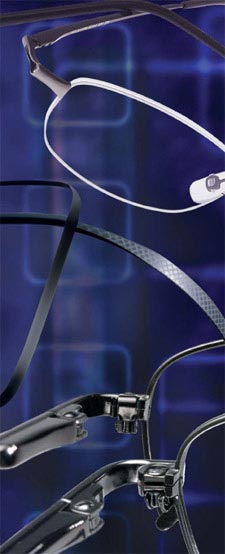 By David Chute By David Chute
New frame technologies are actually no-brainers for optical retailers looking to offer quality, convenience and clever yet honest marketing talking points to their customers. Informed reliance on the vast array of new frame technology leads to increased sales and profit, and most importantly, customer satisfaction as well as referrals. Although the rate of technological change has been relatively rapid and well communicated in optical lenses and contact lenses, it has not been as quick or well understood in frames. On an industry wide level there have been three fundamental and widespread technology innovations in recent years: magnetic clips-ons; the increased use of advanced metals such as Flexon and Beta Titanium; and the explosion in "barely there" eyewear enabled by the replacement of screws and nuts with pressure-fit fasteners in drilled rimless eyewear like Silhouette's Titan Minimal Art and Marchon's Airlock.
Looking to the future, the pace of innovation in frames should continue, as there are several new technologies just now entering the market, or in development, set to dramatically improve a frame's look and function.
One of these new tech-trends enhances and extends the “barely there” look in eyewear via the evolution of so-called “floating” lenses. This newest development in three-piece mounting systems enables a new look by eliminating the need to drill holes or notches to fasten metal hardware onto lenses. These floatinglens systems attach to the lens through micro-cables or thin steel bands that entrap the lens inside a channel cut into the lens edge. This provides better vision since there are no peripheral distractions at the side of each lens; and, equally important, offers a less obstructed view of the wearer’s face by eliminating all metal intrusions inside the lens perimeter. This frame-to-lens mating system has the added benefit of being relatively straightforward for processing in a lab.
Viva recently introduced their PURE Eyewear collection, which uses a micro cable made of small filaments to encircle each lens between the bridge and end-piece. The cable is tightened through mini-screws in the end-piece once the lenses are cut, grooved and inserted. This uncomplicated process entraps and holds the lenses in place. The end-piece and bridge appear to hover on the side of the lens, since they do not intrude inside the lens perimeter.
A similar technology, not yet on the U.S. market, is being developed and marketed in Italy. This system utilizes a continuous, thin band of stainless steel that rests inside a narrow lens groove. The thin stainless-steel band is tightened after the lenses are cut and inserted by pulling them together behind the bridge. Whether this approach (or others still in the research and development phase) makes it to market, the “floating lens” look offers a dramatic new alternative to traditional rimless eyewear.
Another new tech trend gaining both dispenser and lab (and consumer!) interest has been the elimination of traditional screws with fasteners that will not loosen or fall out. This movement toward screw-less eyewear accelerated when Silhouette and others devised pressure- fit lens systems, virtually eliminating screws and nuts in drilled rimless eyewear. As a sort of alternative off-shoot to these pressurefit systems the new V-Lock system from Viva (Editor’s note: Author David Chute’s i2C Ventures played the key development role bringing this tech to market. See sidebar above.) eliminates the eye wire screw in metal frames by using an integrated cam and closure block system. V-Lock uses a micro spring steel cam arm that opens the upper and lower closure blocks wide enough to allow a traditionally beveled lens to be inserted. When the cam arm is closed, it snaps into a channel cut into the back and top of the closure block, locking the lens in place. V-Lock does not require special processing tools and will not open accidentally.
Another innovation to eliminate screws is being developed by Microvision Optical through their TempleLock system. This system utilizes a barbed stainless-steel pin and an injection molded bushing to hold the barrels of the temple hinge together. This eliminates the risk of a threaded screw backing out and secures the temple from loosening or falling off. TempleLock could be on the market by late 2007.
STRAIGHT CHUTE-ING
 David Chute is the founder of i2C Ventures, a tech development firm. In that capacity he functions as a catalyst to both develop inventions and introduce them into the market for a number of high-tech solutions for clients in the optical arena. As such, Chute has been a key creative cog in the concept of V-Lock, a highly viable alternative to the oftenfrustrating eyewire screw system used in eyewear frames. The concept behind V-Lock was first thought of by a retired TV exec with no previous optical experience. The inventor spent a decade developing alternative designs. By early 2003, the idea was turned over to Chute. Dispensers frequently encounter frustrated consumers who can't understand why their lens just fell out; and lab managers know eyewire screws can be slow to process and lead to stripping if not inserted properly. Beginning with the initial concept, Chute’s i2C Ventures worked closely with ECPs until the current refined version was developed. Viva has licensed the technology after having it tested and approved by outside ECPs and optical labs. V-Lock uses a spring steel cam arm to open a gap between the eyewire closure blocks, into which a lens can be inserted. After the lens is inserted, the cam arm is closed, locking it in place. V-Lock can be used with all different sizes and types of lenses and is currently featured on numerous styles in the Viva and Savvy V-Lock collections. David Chute is the founder of i2C Ventures, a tech development firm. In that capacity he functions as a catalyst to both develop inventions and introduce them into the market for a number of high-tech solutions for clients in the optical arena. As such, Chute has been a key creative cog in the concept of V-Lock, a highly viable alternative to the oftenfrustrating eyewire screw system used in eyewear frames. The concept behind V-Lock was first thought of by a retired TV exec with no previous optical experience. The inventor spent a decade developing alternative designs. By early 2003, the idea was turned over to Chute. Dispensers frequently encounter frustrated consumers who can't understand why their lens just fell out; and lab managers know eyewire screws can be slow to process and lead to stripping if not inserted properly. Beginning with the initial concept, Chute’s i2C Ventures worked closely with ECPs until the current refined version was developed. Viva has licensed the technology after having it tested and approved by outside ECPs and optical labs. V-Lock uses a spring steel cam arm to open a gap between the eyewire closure blocks, into which a lens can be inserted. After the lens is inserted, the cam arm is closed, locking it in place. V-Lock can be used with all different sizes and types of lenses and is currently featured on numerous styles in the Viva and Savvy V-Lock collections. A third new frame technology has been the development of increasingly functional and attractive magnetic clip-ons. Magnetic clip-ons are one of the fastest growing segments of consumer interest in the optical industry. First generation magnetic clip-ons required magnets on the Rx frame as well as the clip. Though functional, this tends to add extra weight and mass to the frame, while creating a space between the clip and frame. This "gap" enables a slight amount of light to leak between the sun and lenses. A new, patented technology licensed to Marchon eliminates the need for magnets on the Rx frame, enabling the clip to be mounted directly to the eyewire. When the clip-on is in place, it looks much more like a traditional Rx sun style. The light leakage is virtually eliminated as well as the need for magnets on the frame. Marchon's UltraClip system will be launched through the Nautica division in early 2007.
Although the pace of technological change in the frame industry may not match that seen in computers, the Internet or consumer electronics, it is possible that we will see more significant new frame technologies in the future, which can mean more opportunities for frame dispensers to offer better products to their eyewear customers.
|
 By David Chute
By David Chute
 David Chute is the founder of i2C Ventures, a tech development firm. In that capacity he functions as a catalyst to both develop inventions and introduce them into the market for a number of high-tech solutions for clients in the optical arena. As such, Chute has been a key creative cog in the concept of V-Lock, a highly viable alternative to the oftenfrustrating eyewire screw system used in eyewear frames. The concept behind V-Lock was first thought of by a retired TV exec with no previous optical experience. The inventor spent a decade developing alternative designs. By early 2003, the idea was turned over to Chute. Dispensers frequently encounter frustrated consumers who can't understand why their lens just fell out; and lab managers know eyewire screws can be slow to process and lead to stripping if not inserted properly. Beginning with the initial concept, Chute’s i2C Ventures worked closely with ECPs until the current refined version was developed. Viva has licensed the technology after having it tested and approved by outside ECPs and optical labs. V-Lock uses a spring steel cam arm to open a gap between the eyewire closure blocks, into which a lens can be inserted. After the lens is inserted, the cam arm is closed, locking it in place. V-Lock can be used with all different sizes and types of lenses and is currently featured on numerous styles in the Viva and Savvy V-Lock collections.
David Chute is the founder of i2C Ventures, a tech development firm. In that capacity he functions as a catalyst to both develop inventions and introduce them into the market for a number of high-tech solutions for clients in the optical arena. As such, Chute has been a key creative cog in the concept of V-Lock, a highly viable alternative to the oftenfrustrating eyewire screw system used in eyewear frames. The concept behind V-Lock was first thought of by a retired TV exec with no previous optical experience. The inventor spent a decade developing alternative designs. By early 2003, the idea was turned over to Chute. Dispensers frequently encounter frustrated consumers who can't understand why their lens just fell out; and lab managers know eyewire screws can be slow to process and lead to stripping if not inserted properly. Beginning with the initial concept, Chute’s i2C Ventures worked closely with ECPs until the current refined version was developed. Viva has licensed the technology after having it tested and approved by outside ECPs and optical labs. V-Lock uses a spring steel cam arm to open a gap between the eyewire closure blocks, into which a lens can be inserted. After the lens is inserted, the cam arm is closed, locking it in place. V-Lock can be used with all different sizes and types of lenses and is currently featured on numerous styles in the Viva and Savvy V-Lock collections. 












